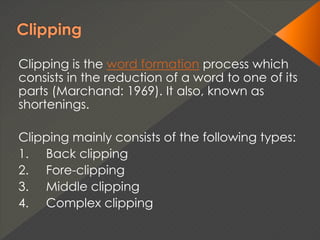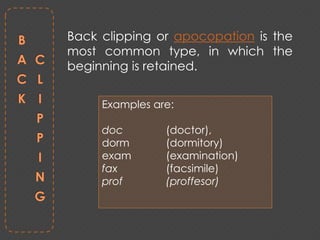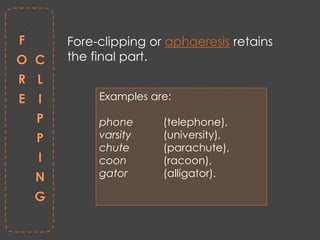Word formation rozi-windie
- 2. яБ▒ How new words are being formed in the language яБ▒ The process consists of a combination of morphemes that are rule-governed (a new word is formed)
- 3. яВЮ Compounding is forms a word out of two or more root morphemes. The words are called compounds or compound words. яВЮ Process that forms new words from two or more independent words
- 4. тАв girl + friend = girlfriend тАв text + book = textbook тАв post + man = postman тАв paper + bag = paperbag тАв note + book = notebook Example of Compounding :
- 5. 1) Since compound words behave as units, between their component elements no affixes (whether inflections or derivations) can usually occur; inflectional suffixes can appear only after compound words. 2) The global meaning of the compound word can often be guessed from the individual meaning of each element of the compound.
- 7. яВЮ Clipping is the word formation process in which a word is reduced or shortened without changing the meaning of the word. яВЮ Process of creating new words by shortening parts of a longer word.
- 8. тАв advertisement тАУ ad тАв examination тАУ exam тАв gasoline тАУ gas тАв gymnasium тАУ gym тАв influenza тАУ flu тАв laboratory тАУ lab тАв mathematics тАУ math тАв memorandum тАУ memo тАв photograph тАУ photo тАв raccoon тАУ coon тАв reputation тАУ rep тАв situation comedy тАУ sitcom тАв telephone тАУ phone Example of Clipping :
- 9. Clipping is the word formation process which consists in the reduction of a word to one of its parts (Marchand: 1969). It also, known as shortenings. Clipping mainly consists of the following types: 1. Back clipping 2. Fore-clipping 3. Middle clipping 4. Complex clipping
- 10. Examples are: doc (doctor), dorm (dormitory) exam (examination) fax (facsimile) prof (proffesor) Back clipping or apocopation is the most common type, in which the beginning is retained.
- 11. Examples are: phone (telephone), varsity (university), chute (parachute), coon (racoon), gator (alligator). Fore-clipping or aphaeresis retains the final part.
- 12. Examples are: flu (influenza), tec (detective), polly (apollinaris), jams (pyjamas). In middle clipping or syncope, the middle of the word is retained.
- 13. Examples are: flu (influenza), fridge (refrigerator), tec (detective), polly (apollinaris), jams (pyjamas). In middle clipping or syncope, the middle of the word is retained.
- 14. Examples are: sitcom (situation comedy), cablegram (cable telegram) Complex clipping is removing multiple parts from multiple words.
- 15. яГ╝ http://www.brighthubeducation.com/esl-lesson- plans/59679-forming-new-words-compounds- clipping-and-blends/ яГ╝ http://www.translationdirectory.com/articles/article 1991.php яГ╝ http://www.ruf.rice.edu/~kemmer/Words/wordtypes .html яГ╝ http://en.wikipedia.org/wiki/Word_formation
















